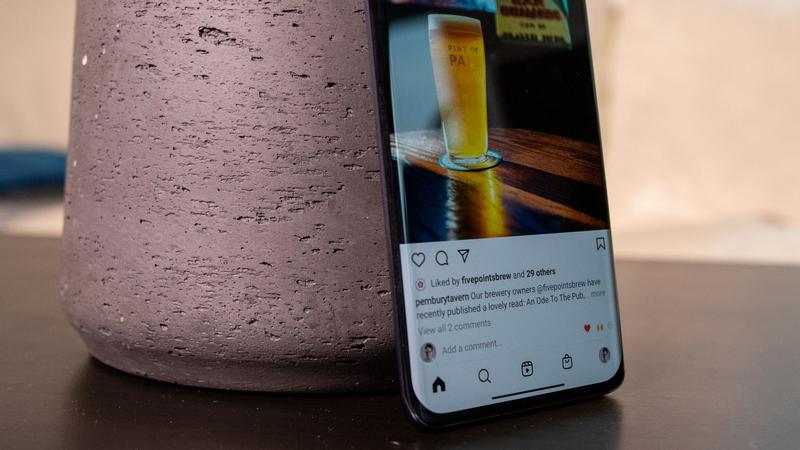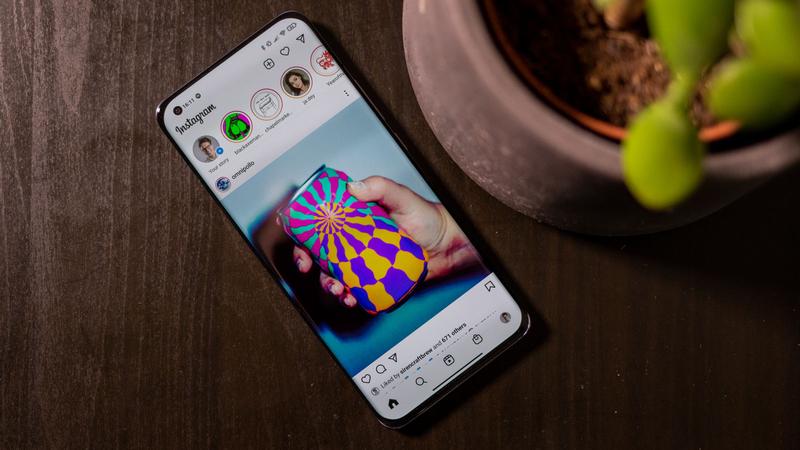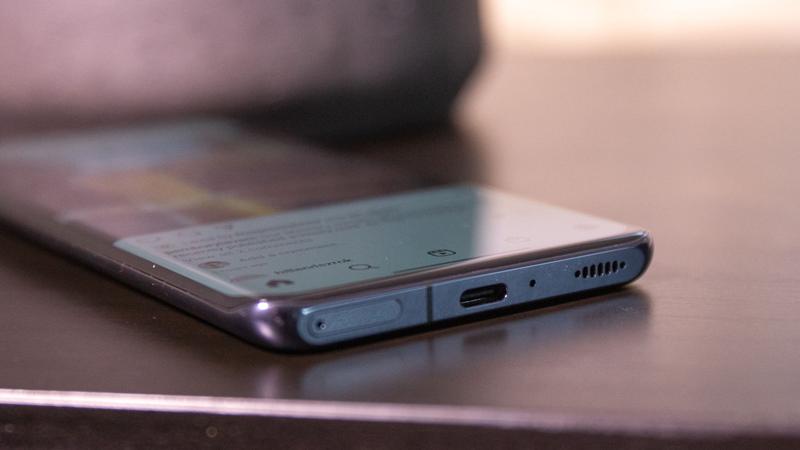The main gripe remains a familiar one – Xiaomi’s MIUI Android skin remains middling at best, and the clunky software keeps tripping the hardware up, holding the Mi 11 back from being truly perfect.
Design & build
I’ve already said that the Mi 11 is big, but it’s worth emphasising. At 164.3 x 74.6mm across the front, it’s only a hair smaller than the Galaxy S21 Ultra – the largest phone in the new Samsung lineup. In Xiaomi’s defence, it’s kept the Mi 11 impressively slim at 8.1mm, which has no doubt helped it keep the weight just below 200g, at 196g for the standard glass model. That means while the phone is undeniably bulky, it at least never feels uncomfortably heavy. Even so, this will be a dealbreaker for many (and of course, a selling point for as many more). While the likes of Samsung, Apple, and OnePlus offer a smaller standard model with the option to upgrade to a larger display, Xiaomi has gone all-in on the big phone, so bear that in mind. Setting the size aside, Xiaomi has applied some lovely touches to the design here. The most noticeable is the quad-curved display, which features a subtle curvature on each of the four sides of the panel. It’s not enough to impact usability – as on some of the super-curved ‘waterfall’ screens – but it really improves the hand-feel of the phone, especially when swiping in from the top and bottom edges. Even curved screen sceptics – of which I am one – should enjoy the implementation here. On the standard edition of the phone you’ll find Gorilla Glass 5 on the back (with the stronger Gorilla Glass Victus over the screen), and Europe gets two colour options: Horizon Blue, and the admittedly slightly dull Midnight Grey (pictured). There’s also a limited edition version wrapped in leather if you can find it. If I had to knock any element of the design other than the phone’s sheer size, it would probably be the rear camera module. Credit to Xiaomi for opting for a bold design, one which accentuates the lenses rather than try to hide them, but I have to admit that the set of mismatched circles and squircles isn’t to my taste – though it may be to yours. It’s also worth noting that there’s no official waterproof rating here to speak of. That doesn’t mean the phone won’t survive a bit of rain, but it does mean there are no guarantees it would survive a drop into the bath.
Display
If the Mi 11 is a large phone, you’ve got the 6.81in display to blame – or thank. This substantial screen is an AMOLED panel with a slim bezel thanks to the quad-curving I’ve already mentioned, and interrupted only by a small corner punch-hole selfie camera. With a 120Hz refresh rate and WQHD+ resolution (1440 x 3200, which nets an impressive pixel density of 515ppi) it’s difficult to fault the screen specs here, and it looks fantastic in most use cases. And yes, you can use that high refresh rate and max resolution simultaneously. Colours are bright and vibrant, and contrast is solid too, while HDR10+ support ensures that it’s a capable display for video playback too. If there’s one fault it’s that max brightness is a little low. This won’t often pose a problem, but I worry that in bright sunlight (which the UK hasn’t had much of lately) visibility might suffer. It also holds back HDR performance, with blacks collapsing together a bit at times – expect the HDR to be good, but perhaps not great.
Specs & performance
There’s less to worry about when it comes to performance, as the Mi 11 was the first phone released to pack the new Qualcomm Snapdragon 888 chipset. The global version of the phone is paired with 8GB of RAM, though in some markets it’s also available in a 12GB variant. Performance in benchmarks is phenomenal, especially on the CPU side, with the highest Geekbench scores we’ve seen outside of the iPhone 12 series. The GFXBench graphics test scores may look underwhelming at first glance, but bear in mind that this is the only phone in our comparison chart running at both 120Hz and WQHD+ resolution, a combination which makes the framerates hit here much more impressive than they may seem.
With benchmarking performance this strong, it should come as no surprise that in day-to-day performance the phone is also a dream. In my two weeks of testing I haven’t hit so much as a moment of lag or a single freeze. As for storage, the Mi 11 ships with a choice of 128GB or 256GB UFS 3.1 storage, though there’s no microSD slot – so that’s all the storage you get. The phone is dual-SIM however, and of course supports 5G over Sub-6GHz bands. You also get the latest Wi-Fi 6E standard support, along with Bluetooth 5.2, making the Mi 11 hard to beat from a connectivity standpoint. Biometrics are handled through optional face unlock and in-display fingerprint sensors – the latter of which is among the fastest and most reliable I’ve tested yet. Unusually, it also doubles as a heartrate monitor. You’ll have to check this within the Mi Health app, and a single scan takes 15 seconds. If you already own a smartwatch or fitness tracker this is unlikely to be any more convenient, but if not then it’s handy to have an easy way to check your heartrate on the go.
Battery & charging
With a 4600mAh cell, battery life in the Mi 11 is unsurprisingly decent, but perhaps not as exceptional as other elements of the phone. It reliably lasts a full day of use, but it’ll be running low by the time it gets there, so you will likely need to charge the phone daily. That’s fine when it’s new, but bear in mind that with battery degradation it’s likely that within two or three years of use it won’t quite make it to sundown so reliably. The comfort here is that charging speeds are phenomenal. Xiaomi ships the phone with a 55W USB-C charger in Europe (unlike in China, where it followed Apple in ditching the in-box plug) and it managed to top the phone up to 79% in 30 minutes, with a full charge not taking much longer. The Mi 11 also supports 50W wireless charging, but bear in mind that you’ll have to buy the charger separately, and Xiaomi hasn’t yet confirmed how much it will charge for a compatible charging pad to make the most of the speeds – the fastest the company sells in the UK right now is a 20W pad. If you don’t mind slower speeds, the Mi 11 is compatible with existing chargers that use the Qi wireless standard (typically much slower at 5W or 10W). It also offers 10W reverse wireless charging for headphones and other accessories.
Camera
The Mi 11 has a triple rear camera array – along with a single selfie shooter – consisting of a main lens, ultra-wide, and macro (there’s no telephoto sadly, perhaps the biggest drawback here). Really though, this camera setup is all about one lens. The main camera is a 108Mp monster, with a large 1/1.33in sensor and an aperture of f/1.9 that combine to allow the camera to capture more light than most rivals. It supports optical stabilisation, and PDAF for focus. While there’s an option to capture at 108Mp, most photos will capture at 27Mp with the help of quad-pixel binning – in which four pixels are combined into one for lower size photos that preserve most of the detail and light capture. In good lighting, there’s very little to complain about with the Mi 11’s main camera. Colours are punchy but remain realistic – there’s no aggressive over-saturation here – and shots are packed with detail, with little noise or artifacting. Shooting in 108Mp cranks up the noise a little, though the resulting increase in detail may make it worthwhile on occasion, especially in good light.
Although the camera app presents a 2x zoom option, this is really just a digital crop, with no proper zoom lens on the hardware here. This is convenient on the fly, but the resulting shots suffer from poor exposure and aggressive sharpening – if you have the time you’ll get better results by taking regular shots and cropping in later. The digital zoom goes up to 30x, but shots are so shaky and grainy that for the most part it’s really never worth it. The 13Mp, f/2.4 ultra-wide may not sound like a serious step down in specs, but I was unexpectedly pleased with the quality of the resulting shots, which remain crisp and well-exposed. There’s an inevitable loss of detail, and the colour-tuning is different here – the saturation and vibrancy are more aggressive, resulting in less natural colours. This isn’t quite best-in-class for an ultra-wide, but for the most part it won’t disappoint. The final lens in the rear trio is a 5Mp macro camera. I’m used to some pretty terrible macro cameras in most phones, so I was pleased to note that it is possible to get good shots out of this one. That’s helped by the rare inclusion of autofocus, though it’s a little loose, so it’ll still take work to get your subject looking crisp. With no stabilisation on this lens shots also come out shaky all too often, and in low-light results get even worse. Ultimately, the macro lens here can get great close-up results out, but you’ll have to be patient, and prepared to put in the work to get them. Finally, turning to the front, the selfie camera is a 20Mp, f/2.2 number. Selfies come out a touch soft – even after turning off the skin-smoothing that’s on by default – but generally the results here are strong too. Both the main camera and the selfie lens are capable of portrait shots. Unsurprisingly the main camera does a much better job at subject and edge detection, only missing the occasional strand of hair, while the selfie camera managed to blur out the frame of a pair of glasses perched on the forehead – far from ideal. Night mode is available on not only the main camera, but also the ultrawide and selfie. In fact, it’s not only available, but switched on by default – much like the latest iPhones, the Mi 11 will automatically switch to night mode in low light, though you also have the option of manually triggering the effect, which seems to prompt a slower, stronger version of the effect. It should come as no surprise that night shots through that main 108Mp camera impress. With the big sensor catching as much light as possible, Xiaomi’s algorithm is able to balance out exposure and reduce blowout, while preserving colours and avoiding washing out the sky. The longer exposure of the full manual night mode definitely loses some detail to blur and occasionally over-exposes scenes, but it also preserves much more colour range than the comparatively muted automatic shots. I’m not sure which I prefer. While night mode is available on both the wide-angle and selfie cameras, results are considerably less impressive. Lighting is uneven, colours artificial, and an unnatural sharpening effect is noticeable. The selfie camera in particular does a decent job at salvaging low light backgrounds, but introduces so much noise and artifacting into faces that it doesn’t seem worthwhile. Useful in a pinch on a night out, but that’s about it. As for video, the Mi 11 can record up to 4K@60 or 8K@30 on the rear, or HD@60 on the front. It also features a few new video modes called ‘movie effects’ that let you do things like freeze specific elements of the frame, or re-create the iconic cinema dolly zoom (here dubbed ‘magic zoom’). They’re fun, but finicky to pull off and obviously very situational. Great for TikTok no doubt, but I doubt you’d find yourself reaching for them often otherwise.
Software
So far I’ve focussed on the Mi 11’s hardware, and the phone excels on that count. Unfortunately, despite improvements to Xiaomi’s MIUI Android skin, the software side remains the stumbling block. MIUI 12 here sits on top of Android 11. From an aesthetic perspective Xiaomi has reined itself in a little, and most Android users should find the experience familiar enough, with little to object to once you play around with a couple of settings. Unfortunately, over time the frustrations build. Chief among them are notifications, which are far from reliable; all too often I’d open WhatsApp to suddenly receive a deluge of messages from the last hour or two. Setting WhatsApp exceptions in the aggressive memory and battery management software helped somewhat, but hasn’t fixed the problem entirely. Other irritations are less crippling. It’s all too easy to actually drag a notification down into a ‘floating window’, leaving you stuck with a tiny version of an app hovering around when all you wanted to do was read a message. Sometimes the volume slider just doesn’t appear when you press the volume buttons, leaving you unable to adjust distinct volume sources separately without diving into the full settings menu. Even the strong camera isn’t devoid of app awkwardness. Like most Android camera apps the settings are littered about nonsensically – why is the macro lens hidden in the aspect ratio menu, rather than with the other camera modes? More frustratingly, by default the camera shoots in the ‘Full’ aspect ratio – which confusingly means ‘full screen’ rather than ‘full photo’, and in fact crops your images to 20:9 to fit the display best, leaving you with weirdly narrow shots and a very tight field of view. Make sure to switch to 4:3 if you want to actually use the full camera. The phone also ships with a variety of pre-installed Xiaomi apps, some of which can be uninstalled, and some of which can’t. Take care though – I uninstalled the Mi Health app, only to discover it isn’t in the Play Store and so can’t be re-installed without sideloading via an apk. Bemusingly, the Disney+ app is also listed as unavailable for the phone on the Play Store – though I can’t say if that’s Xiaomi’s fault or Disney’s. Most of these problems are slight and easy enough to overcome, but it’s not really on to have to worry about them at all on a phone that costs €749. This more than anything, is the reason I’d still caution less tech-savvy buyers to look at Samsung, Google, or OnePlus phones instead – not to mention an iPhone.
Price & availability
The Mi 11 costs £749/€749 with 128GB storage, and £799/€799 for the 256GB model – a modest enough jump that I’d recommend most people to spend that little extra, especially since there’s no expandable storage option. There are no plans at all for a US launch though, so American readers should look into imports – the Euro prices equate to around $910 and $970 respectively. The price sets the Mi 11 squarely up against the £769/$799 Galaxy S21, the £799/$799 iPhone 12, or the £799/$899 OnePlus 8 Pro – likely soon to be replaced by the OnePlus 9 Pro. On specs alone the Mi 11 would give any of those a run for their money, so really the software experience is the only thing that should give you pause for thought. Check out the rest of our best phone ranking for more options.
Verdict
The Mi 11 is a fantastic bit of hardware for the price. The fastest chipset around, a beautiful display, and strong cameras are all packaged within a lovely bit of industrial design. Some will miss the IP rating, though for me the bigger downsides are the choice of a macro over a telephoto lens, the only average battery life, and a software experience that still lags behind the key rivals. Tech Advisor’s Deputy Editor, Dom covers everything that runs on electricity, from phones and laptops to wearables, audio, gaming, smart home, and streaming - plus he’s a regular fixture on the Tech Advisor YouTube channel.













